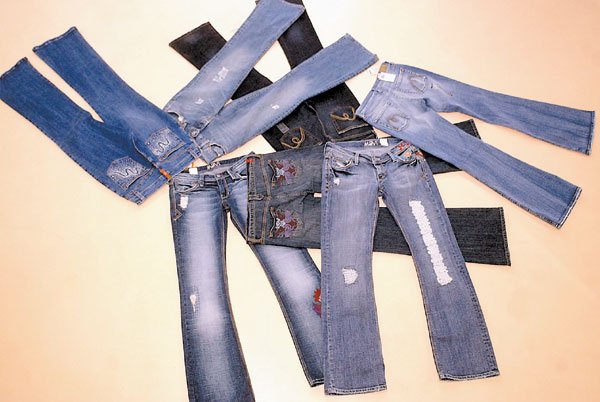The evolution of an American fashion staple
When Levi Strauss, a Bavarian immigrant who lived in San Francisco, partnered with tailor Jacob Davis in 1872 to create denim work pants faceted with metal rivets, he probably never imagined that the pants would evolve into designer-made staples in the fashion world. Nor did he likely imagine that the jeans would be adorned with rhinestones, deliberately faded and cut in hundreds of different fits.
Jeans can be dressed up or down, worn for comfort or for style, and although the look of the most commonly worn pants in the United States is constantly changing, some denim experts say jeans will never go out of style.
“They’re comfortable and they change with the times,” said Bobbi Villanueva, manager of Calvin Klein at the Gilroy Premium Outlets. “We carry the hot trends and the classic jeans. The classic look is always popular and a good seller.”
Despite their many elaborate variations today, American blue jeans had a working-class beginning. Strauss and Davis promoted the pants and overalls for the workers of the West. But during the 1930s, the jeans became a fashion staple, partly because of their growing prominence on the big screen.
Still today, actors, musicians and other celebrities set the trend when it comes to what jeans are in style. Gaining instant popularity on shows such as “Desperate Housewives” and “Las Vegas,” celebrities have helped boost embellished jeans to the status of the must-have garment for fall.
Deborah Wood, owner of the downtown Hollister boutique Drapeol, said everything from embroidery to rhinestones is in. Caring for these jeans, which can run anywhere from $30 to $300, can take some extra work. Although the higher price tags can be a downer, with denim, you get what you pay for, Wood said. And if you are willing to pay more, it might be worth the effort to take care of the garment.
“I recommend turning (the jeans) inside out and buttoning and zipping them,” she said. “Wash them in cold water and lightly dry. If the jeans are cheap, chances are the rhinestones may fall off.”
While shopping at the Gap in the outlets this week, Morgan Hill resident Sharon March said the amount of money she spends on jeans depends on how trendy they are.
“If they’re just a classic pair that I know I can wear for years, I’ll spend the money and get a good pair. But if it’s something I know will go out of style in six months, I’m a little more conservative with how much I’ll spend,” she said.
Along with the rips, tears, designs and washes that make jeans must-haves, Wood said the most important aspect of picking out a pair is the fit.
“The most important thing is how they make your butt look,” she said. “You want a good fit and a good fabric.”
In most cases, a good fit goes along with a hefty price tag. Although some may think expensive jeans are costly because of the brand name, Wood said it has to do with the quality of fabric and the fit of the jean.
Another trend in the denim industry is the repetition of certain fads. The sequins, embroidery and “denim artwork” that is stylish today was just as popular when in debuted in 1973, according to the Levi Strauss Co., which called the trend the “decorated denim” craze and even sponsored a denim artwork contest.
Bellbottoms, cropped jeans and Capri-style jeans – designed to end near the mid-calf or just below the calf – have managed to come back around, and Wood said the dreaded tapered-leg jeans may be on denim’s horizon.
And while men might not be wrestling with the decision between rhinestone-studded pockets and an embroidered butterfly on the legs of their jeans, Wood said style still matters to them.
“They’re not just about the ones that fall off their butts anymore,” she said. “They want something with style that fits well.”
Both men and women are buying the most popular cut to hit the market in the past few years – low-rise. The jeans sit right at the hip, a fit that Villanueva said makes the jeans comfortable for any body type. And for someone who has a few extra pounds, Wood recommends finding a denim with stretch in it.
The embellishments, rip marks and designs that can be found on the legs and butts of jeans-owners all over the world are another way of expressing individuality, according to Villanueva.
“It’s a way for people to feel unique,” she said.
Jeans will always stay in fashion because of their comfort, Wood said. The only reason people buy new pairs is because their bodies are constantly changing, she said.
“(Jeans are) the most comfortable and flattering thing someone can wear,” she said. “I mean, we all think sweat pants are comfortable, but they’re not all that flattering. With jeans, you get both.”














